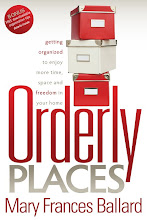 Well, this update isbetter late than never! The deer have eaten 90% of our azaleas and camellias so there are few flowers to enjoy this spring. It is good, however, to have warm weather after an unusually wet, cold and messy February and March.
Well, this update isbetter late than never! The deer have eaten 90% of our azaleas and camellias so there are few flowers to enjoy this spring. It is good, however, to have warm weather after an unusually wet, cold and messy February and March.
On the days that are left this month, take some time to organize your linens and bathroom(s).
If space is limited in linen closets, consider placing extra sheet sets in the bedroom where they are used. They can be stored in closets, inside under the bed containers or even under the mattress of that bed.
Replace heavier bedding with lighter weight items. Some quilts or comforters need only to be put through the “air” cycle on the dryer to remove dust. Store them in pillow cases or the large plastic bags now available to keep them clean. Vacuum bags can also be used but be aware they will gradually allow air to return.
Remove sheets, blankets, etc. that are torn or in disrepair. If they can be fixed, find someone to do it, otherwise, recycle them to local pet shelters or other appropriate places.
We often collect pillows and other bedding to have on hand in case guests stay overnight. Evaluate what you have that has rarely or never been used. Perhaps some of them can replace those you have removed, or they can be donated or sold to allow room for better organization of the space.
Make similar decisions about your bathroom linens. Towels and wash cloths that are in disrepair should be removed and replaced with those you have been saving for a special occasion or purchase additional items on sale. Most department stores have linen sales throughout the year and discount or outlet stores also offer good savings. I suggest rolling towels to make it easier for children (or some adults) to select their favorite from the stack with the least amount of disturbance to those remaining.
Many cotton items will dry rot if not used over a period of time. This often occurs on the folded edges so check those that have been sitting on the shelf for a longer period of time.
Clear the bathroom counters and contain any times that must remain there. Use trays, baskets, bins, etc. to make clean up easier there. I love the portable totes that can be easily moved to other storage areas. Give one to each person using the bathroom is space is limited. Be diligent in removing old or expired products and store duplicates of items in another area.
Be sure all products in the bathroom have a label. This is especially important with medicines. You may check out taking expired medicines to your local pharmacy or ask them the best way to dispose of them. Flushing in the toilet or garbage disposal is no longer recommended because of contamination of local waters.
If the bathroom needs updating, consider using hooks rather than bars for towels. Children find them much easier to use so be sure to put those lower on the wall or door. Consider using dark or disposable towels for removing make-up
Placing a magnifying mirror on the wall saves space and is more convenient that a portable model. Using pull out shelves or wire baskets under the sink will make access much easier to items stored in the back of those cabinets.
Keeping these areas organized requires daily maintenance because of daily use. Setting up a schedule and requiring participation of all the family members can help keep them clean and neat.
Hopefully you have finished your tax forms for this year. If you would like some help in deciding which papers you need to keep, here is a link to a chart of retention guidelines I posted today.



